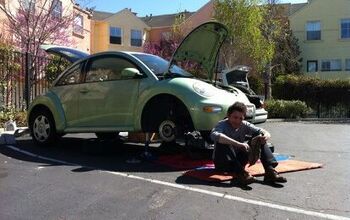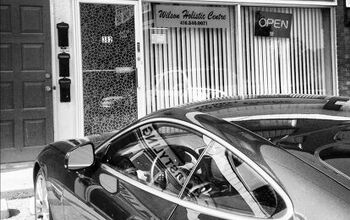QOTD: What's the Best Winter Car Recipe?

Weather forecasters deserve our scorn, and Northerners know why. They call for one to two inches of snow, update the forecast to four to six inches later in the day, and you wake up the next morning to find eight to twelve inches of fresh powder blanketing your driveway, your car, your life, your fragile psyche.
It happens every winter, but a good insurance policy against aorta-popping fits of rage (and exertion) is to get yourself a good winter vehicle. Something that eats snow and ice for breakfast and comes back for more. Ideally, it’s a low-cost, no-commitment “beater” that throws itself in front of winter’s bullet to spare your pampered summer ride, but not always.
That’s never been the case for this writer, but we’re a diverse society. A more civilized friend of mine abandons his XJ8 to slum it in a Cadillac DTS when the snow flies. For many, an all-wheel-drive crossover, four-wheel-drive pickup or Subaru Outback daily driver is the best tool for the job.
I never thought my lowly Chevrolet Cruze performed all that hot in the white stuff, but it got me home through a 20-inch snowfall last winter. Kudos to the quiet one. Living in Canada, you quickly realize that a manual transmission + cheap FWD car = decent winter rig. Assuming, of course, that you’ve invested in halfway decent snow tires.
My best winter beater was a base model 2003 Grand Am — one of two that I’ve owned. Thanks to its (very) low price, fairly torquey 2.2-liter Ecotec four-banger and five-speed Getrag, that nondescript grey sedan made a meal out of snowy roads. It also had a pleasant knock-around factor. Yes, it’s sometimes nice to not have to care if your vehicle sustains cosmetic damage.
So, B&B, what’s your recipe for the perfect winter vehicle? What combination carried you through the worst that winter has to offer? Sound off in the comment section below.
[Image: a2050/ Flickr ( CC BY-NC 2.0)]

More by Steph Willems
Latest Car Reviews
Read moreLatest Product Reviews
Read moreRecent Comments
- Buickman I like it!
- JMII Hyundai Santa Cruz, which doesn't do "truck" things as well as the Maverick does.How so? I see this repeated often with no reference to exactly what it does better.As a Santa Cruz owner the only things the Mav does better is price on lower trims and fuel economy with the hybrid. The Mav's bed is a bit bigger but only when the SC has the roll-top bed cover, without this they are the same size. The Mav has an off road package and a towing package the SC lacks but these are just some parts differences. And even with the tow package the Hyundai is rated to tow 1,000lbs more then the Ford. The SC now has XRT trim that beefs up the looks if your into the off-roader vibe. As both vehicles are soft-roaders neither are rock crawling just because of some extra bits Ford tacked on.I'm still loving my SC (at 9k in mileage). I don't see any advantages to the Ford when you are looking at the medium to top end trims of both vehicles. If you want to save money and gas then the Ford becomes the right choice. You will get a cheaper interior but many are fine with this, especially if don't like the all touch controls on the SC. However this has been changed in the '25 models in which buttons and knobs have returned.
- Analoggrotto I'd feel proper silly staring at an LCD pretending to be real gauges.
- Gray gm should hang their wimpy logo on a strip mall next to Saul Goodman's office.
- 1995 SC No


































Comments
Join the conversation
When I lived in Ohio, my first winter car was a '77 VW Rabbit with mechanical fuel injection.(Great car) I had to sell it after it rusted so bad, the drivers seat started falling through the floor. LOL. However, it was super reliable. My second beater was a '84 Celica GTS. Enjoyable to drive, but RWD made it a horrible winter car. My next beater was a '87 Dodge Colt hatchback. Another reliable, great car. I purchased it for $300, then drove it 3 years, then sold it for $300. How could I honestly complain. My final beater, was a '95 Escort sedan. My first American beater. It wasn't bad...but the reliability did not compare to my foreign predecessors. I think the best part about ALL beaters is...you can park them anywhere with no worries. Go-ahead...ding my car. LOL. I absolutely loved parking next to a new BMW, and hopefully catch the reaction of the driver. Priceless!
Here's an article on why 'winter beaters' are a bad idea in Canada. From the Globe and Mail back in 2015. Below are key excerpts: “I would not recommend running an old, cheap, beater car for winter use,” said Raynald Marchand, general manager of programs for the Canada Safety Council, in an e-mail. “You need reliability, and all the new safety features on your side in bad winter driving – since most people would not spend money on the old beater car, the safety concern is even worse.” Said Calvin Feist, automotive instructor at the Northern Alberta Institute of Technology (NAIT) in Edmonton. “I personally don’t believe in winter beaters – I drive the same vehicle all year and maintain it so I have no worries,” Feist said. “When it is ready to be replaced, I do so.” “Winter beaters are not cheap or really easy to find anymore,” said Sean Cooney-Mann, store manager for an OK Tire in Toronto. “Good used cars have risen in value due to new safety standards.” An older car is more likely to need repairs, even if it’s just for wear and tear like tires and brakes. That will add to the price tag. And then you’ll need a place to park a beater – if you’ve got no room in the garage, do you really want to be scraping ice off your beater at six in the morning? Or to pay for storage for your real car? And you’re also paying for insurance for the beater. And, if you’re in Ontario, you’ll need to make sure the beater passes its used car safety inspection and emissions tests. http://www.theglobeandmail.com/globe-drive/culture/commuting/the-winter-beater-a-good-idea-or-bad/article33370200/